Tamela Rich's Blog, page 8
December 17, 2014
Lessons on Gift Exchanges: Stuff ≠ Love
I met “Sheri” a few years ago on my book tour and she got in touch when she moved to Charlotte (my city) in March. She arrived at exactly the same time we were moving out of our suburban four-bedroom home into a smaller urban townhouse and came over to preview the massive yard sale that took us weeks of preparation. She bought a few things that she admitted she didn’t need and I was happy to sell them.
She had moved a couple of times in the last few years and as she was shopping our yard sale, we talked about how difficult it is to move things along that no longer serve us: clothes that don’t fit, LPs without the proper equipment to play them, birthday cards from high school sweethearts…I won’t belabor the point. I had it all and struggled to downsize.
I bet you’re wondering what that funny picture is at the top of this post. It’s what a Play-Doh elementary school geography project looks like after all the moisture has evaporated. A “good mother” saves these precious school projects for twenty years, dontcha know (ha!).
On the edge of something frightening
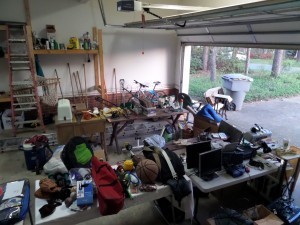
Preparing for a downsizing-induced yard sale takes weeks
Sheri got in touch last week in great distress. She had come to the conclusion that she was drowning in her stuff and didn’t know how to make decisions about what to save, and what to throw out, donate, or sell. She confided that she was obsessing over this massive undertaking, which robbed her of sleep and was edging into her sanity.
I am not a mental health professional, but I’ve been fortunate to work with some of the best. Her tone of voice and obsessive repetition of points told me she wasn’t being a drama queen.
She was on the edge of something frightening.
I could only speak to her from my own exhausting experience of downsizing and lovingly suggest how to cope, both with her stuff and with her thoughts.
Stuff ≠ Love
I’m going to stay in touch with Sheri over the next few weeks. She’s new to Charlotte and doesn’t have many people to call on for support. It’s the least I can do to make a small dent in the karmic debt I owe to friends who’ve helped me in life.

“The Gift of Truth excels all other Gifts.” ~Buddha
But as we come into the season of gift exchanges, I think it’s important to get real with ourselves. Few of us want for anything. Think of my friend Sheri, for whom one more gift to deal with might be the proverbial straw that breaks the camel’s back of her sanity. I’m sure she’d rather have an hour with a friend over a steaming mug of coffee than a 300th pair of earrings.
If you’re struggling with what to buy for “someone who has everything,” the answer is probably, “don’t buy them anything.”
We can emerge from under this sea of stuff in some loving ways. One is to give each other gifts from the heart, as my friend Jeri’s famiy does. One year her son took piano lessons on the sly so he could surprise her by playing one of her favorite tunes on the family piano. A priceless and precious gift of love and of self.
Another way to give a precious gift is to donate your time to a worthwhile cause, perhaps in the name of someone you would otherwise buy a trinket for. This week’s podcast about “voluntourism” will interest those who like to travel and be of service to others.
Want to keep Christ in Christmas? Feed the hungry, clothe the naked, forgive the guilty, welcome the unwanted, care for the ill, love your enemies, and do unto others as you would have done unto you.
~Steve Maraboli, Unapologetically You: Reflections on Life and the Human Experience
December 14, 2014
Voluntourism for Baby Boomers and Gen Xers
A story on NPR earlier this year says voluntourism—volunteering while on vacation—is one of the fastest growing trends in travel today.
More than 1.6 million volunteer tourists are spending about $2 billion each year in the communities they serve. This does not include the value of the projects they are involved with.
Research quoted in the NPR story indicates most volunteer tourists are Millennials between the ages of 20 and 25, and predominantly female. College students often take up voluntourism to boost their resumes or gain experience in fields that require international travel.
Motorcycle voluntourism

Ouma, who is raising six orphans, now has a new home thanks to Wellspring International Outreach
Today’s podcast guests offer voluntourism by motorcycle to benefit orphans in developing countries. But their voluntourists are Baby Boomers and Gen Xers, not Millennials. Neale Bayly and Drew Alexander of Wellspring International Outreach talk about this unique take on voluntourism.
Drew heads up operations for White River, South Africa, where Wellspring riders recently built a home for a grandmother raising six children and a hut to replace the one a twelve-year-old boy was living in until it collapsed on him in a rainstorm. More about those stories in the podcast.
Neale is the star of Neale Bayly Rides, a three-part reality TV series that debuted in 2013 on what’s now Fox Sports 1. In that series and in his voluntourism service projects, Neale uses motorcycle travel—often through extreme riding conditions—as a way to “soften affluent people up” to humanity. This allows the rider-volunteers to become emotionally available for the service projects at the end of their adventures.
For many voluntourists, the prospect is overwhelming.
As Neale says, “Culture shock is a tough thing to deal with…Sometimes you don’t know know you’ve got it…It’s like getting vertigo in the mountains; you can’t look up and look down at the same time.
Some people repel it, some people immediately embrace in, others jump in full throttle, and other people are ambivalent.”
The genesis of Wellspring International Outreach’s voluntourism
Neale’s TV series introduced the world to his charity work with Wellspring International Outreach, which he founded six years ago to help further the work at the Hogar Belen orphanage in Moquegua, Peru. As he described in our TEDx Charlotte talk earlier this year, he was inspired to help the Peruvian orphans by Father Gio, a Canadian Catholic priest whom Neale met by chance encounter in the Andes over 20 years ago.
Click here to view the embedded video.
I hope you’ll click the “play” button at the top of this post and listen to Neale and Drew talk about their work. The stories they tell from their recent trip to South Africa will explain the transformation they’ve seen in themselves and in others who accompany them on these service projects and raise funds for ongoing operations.
December 2, 2014
6 Places to Observe Pearl Harbor Day—Without Going to Hawaii
When the Japanese attacked Pearl Harbor, Hawaii 73 years ago this week, President Franklin Delano Roosevelt called it “A day that would live in infamy.”
Few of us were alive in 1941 when the attack brought us into WWII, so National Pearl Harbor Remembrance Day helps us to honor those who perished. The flag should be flown at half-mast each December 7.
Six places to observe National Pearl Harbor Remembrance Day
Want to observe and honor the event but can’t make it to the actual historic site in Hawaii? Here are six observances within the lower 48 states:
1. Washington, DC: It’s worth a trip to the WWII Memorial in our nation’s capital to reflect on Pearl Harbor Day. Don’t miss the official inscription commemorating Pearl Harbor.
While you’re in the city, visit the U.S. Navy Museum in Washington, DC has an exhibit called “In Harm’s Way: The U.S. Navy and WWII,” which follows events in chronological order from Pearl Harbor to VE and VJ days.
2. Charleston, South Carolina: The Sons and Daughters of Pearl Harbor Survivors are holding their annual convention in this Southern city on December 4-8, 2014.
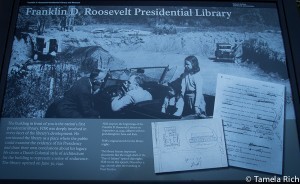 3. Hyde Park, New York: The FDR Presidential Library and Museum has a collection of documents (available in PDF for review from your computer screen) related to FDR and his response to Pearl Harbor. I saw some of these when I visited in September 2014.
3. Hyde Park, New York: The FDR Presidential Library and Museum has a collection of documents (available in PDF for review from your computer screen) related to FDR and his response to Pearl Harbor. I saw some of these when I visited in September 2014.
Some conspiracy theorists believe FDR knew about the attacks in advance or “tricked” the Japanese into the attack, and the documents show a diversity of views on this issue. Most scholars view Pearl Harbor as the consequence of missed clues, intelligence errors, and overconfidence.
4. Fredericksburg, Texas: The National Museum of the Pacific War is hosting a Pearl Harbor Observance, which features “patriotic music, presentation of colors, rifle salute, and guest keynote speaker will be a part of the ceremony.”
5. Phoenix, Arizona: The State of Arizona is hosting a Pearl Harbor Remembrance Day event at the Wesley Bolin Memorial Plaza, including a keynote speaker, wreath laying ceremony, and access to the State Capitol Museum.
6. Your living room, Anytown, USA: Curl up for an evening of personal reflection by watching clips of Pearl Harbor from Ken Burns’ The Roosevelts: an Intimate History series (check local PBS listings for rebroadcasts or order your own copy from Amazon.com).
Since visiting FDR’s Little White House earlier this year, I’ve been reading No Ordinary Time by Doris Kearns Goodwin, which chronicles the lives of Franklin, Eleanor and their inner circle during WWII. The reading experience has been enriched by my visits to not only Hyde Park (where he was born and home to his presidential library), and Warm Springs, Georgia (where FDR died) but also to Campobello Island, New Brunswick (where he was diagnosed with polio.)
Friends, history comes to life when you travel and it’s as interesting as anything you might call “entertainment.” Get out there!

November 25, 2014
Six Ways to Avoid Airline Baggage Fees
Thanksgiving week is the busiest time for American travelers. In an attempt to maximize profits, airlines have made it more difficult for your bags to qualify as a free carry-on while simultaneously raising baggage fees.
Here’s the good news: you don’t have to blow your travel budget on baggage fees.
The tips I shared with WCCB News Rising will help you avoid airline baggage fees
Step One: Decide on a basic color palette. This will help you minimize what you pack. Every top should go with every bottom and everything should match one pair of boots/shoes. If you’re taking boots, wear them and pack your other shoes in the carry-on since they take less space.
Choose accessories that are easy to pack, like scarves. And instead of packing every bulky sweater you own, take one and pack a base layer to keep warm under your other clothes.
For the four-day Thanksgiving holiday, I travel in a pair of jeans, a long-sleeve shirt with scarf and vest, and wear my boots. I pack a second pair of jeans, three long-sleeve shirts, another vest and three scarves. In addition, I pack yoga pants and a T-shirt, a pair of pajamas, underwear, a base layer, socks and walking sneakers. Add my personal care products and I’m done.
Step Two: Rethink those appliances. Don’t pack a hair dryer because hotels, motels and even some KOA campgrounds already have them. A razor is smaller than an electric shaver, so go with that. If you have a specialty appliance (like a flat iron for your hair) pack it if you must—you’ll have more room since you’ve left the hair dryer at home.
Step Three: Ship ahead / buy when you arrive.
Families with small children: there are diapers in every town and village across the country. Buy them when you arrive. If you’re headed to a hotel, or won’t have your own transportation when you arrive, ship them ahead (easy with Amazon Prime’s free shipping). One mom I interviewed for my story suggested packing a diaper for every two hours of travel. Another mom said not to pack a toy your child hasn’t played with in the last three days.
If you’re traveling from temperate zones to somewhere much colder, go ahead and ship your parkas, snow boots and other hefty gear. While you’re at it, include the larger size liquids and Swiss Army knives that you can’t carry on the airplane in that box.
Step Four: Hand-wash while you’re gone. The guys at News Rising had fun with this one. I use shampoo for my hand washing and body wash. Hotels always have shampoo so I use their cheap stuff on my hand washables and save my own brand for my hair and body. And be sure to watch the video above for how to mash the water out of your clothing to ensure it’s dry in the morning. The entire process only takes three minutes.
Step Five: Roll your clothes. That’s right, instead of folding them, roll your clothes. Even if you compress them in a roll sack like I do, they will travel better and suffer fewer wrinkles rolled. For “finery” and fabrics that easily wrinkle, roll those pieces between layers of tissue paper.
Step Six: Use roll sacks and compression packs within your suitcase/carry-on. I show how to do that in the second video with WCCB News Rising below.
These six tips will help you in the minivan too—who doesn’t need more room?
Where to buy roll-top and compression sacks
I bought my roll sacks at Dick’s Sporting Goods several years ago and my compression sack at a local outdoor provisions company. They are easily found at this search link from the Sea to Summit brand, but other companies make them, too.
You don’t have to buy the more expensive waterproof versions when you’re only going to use them inside luggage—the siliconized Cordura® will do very nicely!
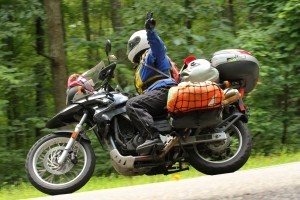 I’ve extensively traveled the U.S. and five Canadian provinces on a motorcycle as pictured here. I’m often gone for weeks at a time and, in addition to my clothing, motorcycle gear and tools, I also pack camping gear. If I can do it, you can too!
I’ve extensively traveled the U.S. and five Canadian provinces on a motorcycle as pictured here. I’m often gone for weeks at a time and, in addition to my clothing, motorcycle gear and tools, I also pack camping gear. If I can do it, you can too!

November 19, 2014
Busted in New Brunswick
My recent road trip through New Brunswick and New England in September, 2014 taught me a valuable lesson about letting go and living in the moment, courtesy of my friend Jill.
I don’t often travel with others, but when I do it’s usually with Jill, whom I frequently mention in my podcasts and blog posts, including this one.

This welcoming sign sits atop Fort Howe
Saint John and the Supermoon
Our easternmost destination was Saint John, New Brunswick, where we pulled in at sunset, a sight I’ll never forget.
There was a “Supermoon” that week, which means the moon was close to the Earth and full; it was so massive that I could have counted the craters and smelled the green cheese.
The sun was setting behind us as the Supermoon rose before us. Jill described it as “A God Moment.”
As we glided into town on the bridge over the harbor on the Bay of Fundy, both the pink-purple skies and that Supermoon reflected in the bay’s still waters like a painter’s landscape. Alas, I have no pictures of it for you; by the time we reached our lodgings it was nearly dark.
Homeport B&B
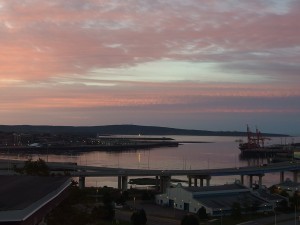
View of Saint John’s sunrise from the Homeport B&B
Speaking of which, while either of us go in for luxury accommodations very often, we adored the Homeport B&B and her owners. Ralph and Karen Holyoak cleaned out their personal garage to make room for our bikes and Ralph met us in the driveway with a flashlight to guide us in. He was born with a hospitality gene.
After settling into our suite, we caught a cab downtown for a terrific meal then walked home, well after 10:00 p.m. Safe and sound.
The B&B is situated on a bluff overlooking the city’s waterfront, where we witnessed sunrise from the glass-enclosed widow’s watch that next morning. Breakfast followed with some delightful fellow guests before we set off on foot for a day of exploration.
Safe, friendly, walkable Saint John
Saint John is designed for pedestrians. I always felt safe, even well after dark. People there are friendly and seem to be satisfied with their lives, judging by the placid looks on their faces. I’ve never before visited a city with such courteous citizens, from retail staff to my fellow patrons at Tim Horton’s. More about that in the podcast at the top of the post.
You hear a lot about English-French tensions in Montreal, but I sensed none of that in New Brunswick, Canada’s only officially bilingual province. Factoid: New Brunswick was visited by Vikings, who called it “Vinland.”

Saint John City Market is a treat for all your senses
Saint John City Market is the oldest farmer’s market in Canada. The market’s roof is shaped like an inverted ship hull and there’s plenty of art and tourist kitsch to tempt you, in addition to international foods and local produce. If you got a Saint John postcard from me, chances are I bought it at the market.
Travel tip: Take a meal from a farmers market. Many of them offer prepared foods in addition to produce. This makes it easy for everyone in your party to grab what suits them. Then, take your food to a scenic overlook or urban perch where you can people watch.
Saint John is packed with churches and historical markers, but there’s plenty of new mixed with the old. The waterfront has a beautiful walking trail that’s dotted with public art and interpretive stands. It takes you from downtown to view the changing Fundy tides at Fallsview Park. We must have walked ten miles that gorgeous September day.
Bay of Fundy tides
When you hear that the Bay of Fundy has the world’s biggest vertical tide change, you might imagine a wall of water like a tsunami coming in twice a day. Nah, that wouldn’t be the kind of place where people could build a life.
To take in the enormity of the tidal change, you have to visit at both low and high tide to compare the striking difference, which can be as much as 50 feet. The Fundy tides inspired a chapter in my new book, as a matter of fact. These links help you understand the four types of tidal effects in the bay.
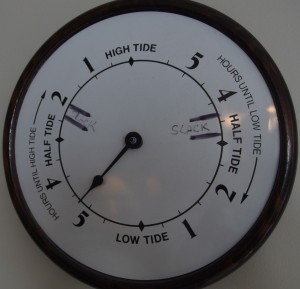
The Homeport B&B features a tidal clock for guests.
Vertical Tidal Effect
Tidal Bore
Horizontal Tidal Effect
Tidal Rapids, Whirlpools & Rips
Our visit came to an end much too soon. I always get a twinge of regret on the turn-back of a trip, but leaving Saint John was especially tough. I had fallen in love with her people as well as the landscape of bluffs, coves and harbors.
Before packing our bags, Jill and I took in the sunrise at Fort Howe, overlooking the harbor downtown. We were both eager to go on our first whale watch later that day in Saint Andrews, some 65 miles east, yet sorry we didn’t have more time in Saint John. We vowed to return, probably en route to Newfoundland and Labrador in the next year or two.
Jill and the GPS
In the thousands of miles we’ve traveled together, we haven’t had a GPS until this trip, when Jill brought her week-old device with her…learning to use it on the go. I did the same thing with the new camera I bought three days before I hit the road. It was our “gadget shake down cruise!”
In our pre-GPS days we took turns as lead rider and navigated with paper maps and Google. But for this trip I fell in behind GPS-enabled Jill and took it easy. In truth, I got a bit lazy in the navigation department as I listened to an audio book about the Roosevelts to prepare for our visit to Campobello Island and Hyde Park. More about those destinations later.
On the way out of Saint John, we crossed over the Bay of Fundy on the same bridge that brought us there under the Supermoon. I noticed Jill’s head jerk toward the pavement and saw what I thought was a piece of generic gray road debris skittering in my direction. I was glad she managed to avoid it and watched as it headed my way. I’ve learned the hard way that bouncing road debris can lead to serious accidents.
Wait a minute, that looks like…
Nah, it couldn’t be…
That IS her GPS, I said as I watched it continue bouncing toward the berm. I was unable to safely stop and pick it up. Saint John is a small city (population 70,000), but we were in traffic, nonetheless.
We pulled over at the next exit. Jill was rightfully upset. The GPS had cost $600 and she hadn’t even received the credit card statement, much less gotten $600 in useful miles with it.
I had the bright idea to call the police to see if they would take her back to the bridge and stop traffic so she could safely retrieve it.
“Tam, I’m too upset. Will you call?”
I did, not really sure I should be asking the local constabulary to get involved in a non-criminal matter, but my philosophy is if you don’t ask, the answer is “no.” The dispatcher happily obliged.
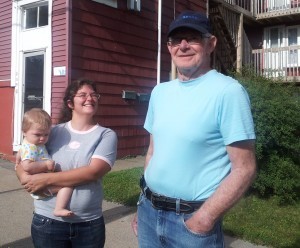
Saint John neighbors who came to see what the “police action” was all about and recommended more places we will visit on our return
While I waited for Jill to return from her recovery mission, a few residents came out to see what the “police action” was about. We chatted a bit and they went on to ask about our visit and suggested some other places we’ll have to catch when we return. Love those Canucks!
Alas, the GPS was barely recognizable by the time Jill found it. The little gray box landed on the opposite side of the bridge from the direction it was headed when I last saw it. Smashed.
The sunny-dispositioned Jill had adjusted her attitude by the time the nice police officer brought her back to her bike. “At the end of the day it’s just stuff,” she observed. “I think God wanted me to see something that I probably wouldn’t have seen if I had just plugged an address into the GPS.”
We bowed our helmeted heads and said a prayer to shake it off. I asked Jill if she needed some time to gather herself before got back on the road, but she said she had put it behind her. She wanted to get to Saint Andrews so we didn’t miss the whale watch. What a trooper. She never brought it up again.
All the great philosophies and religions teach detachment, but Jill really gets it. What a human being.
The past is just a memory. The future is just an idea. Your moment of power is in the present. Seize it.

November 13, 2014
Brattleboro’s Culture Makes You Think
Brattleboro’s culture is legendary. Even its chamber of commerce proclaims “the hippies have had a lasting influence on the town’s character and values.”
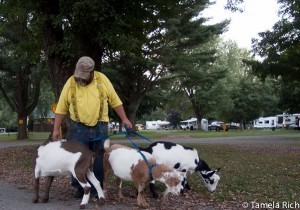
Brattleboro KOA goats on leashes
My friend Jill and I were there for a couple of days, so we were really able to get a sense of Brattleboro, and I can certify the chamber’s description.
Walking down an alley, we just happened upon the musicians in the video at the top of this post. While the video is shaky (because I was walking), the trio was fantastic! I hadn’t seen someone play the washtub bass since I was a kid in front of my grandparents’ TV set watching Hee Haw. Who knew?
We stayed outside the city limits at the KOA campground, where the owners keep a few goats. I have a real love for goats—they crack me up—and I was surprised to see them happily walking on leashes like dogs. Okay, like foraging dogs.
Speaking of farm animals on leashes, we heard about a local resident who frequently walks his pig through town, but since we missed them, here’s a video of what I assume is this duo.
Rush hour the Brattleboro way
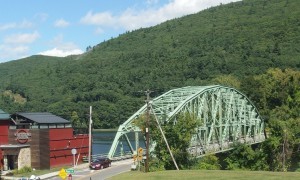
Anna Hunt Marsh bridge: lovely but inadequate
Although it’s a town of less than 7,000 residents, traffic moves slowly through Brattleboro’s main artery, which leads to New Hampshire via the Anna Hunt Marsh bridge. Jill and I walked that bridge in the dappled sunshine of early September…lovely.
The bridge causes delays because it’s narrow—one lane in either direction—and because the railroad tracks cross right in front of it. It’s been deemed functionally obsolete by federal highway standards.
Riding into town one day at noon, we noticed a woman wearing a long, petal-hemmed skirt in vibrant colors. She caught my attention not only for that remarkable skirt, but also because she was waving her arms and using specific hand gestures in what seemed to be an attempt to smooth and settle the energy of the drivers and traffic flow. It looked vaguely to me like Reiki or maybe some other kind of energy work, and she was immersed in her practice. Sure ’nuff, we soon heard sirens responding to a call. By the time we had parked at the food co-op, a fire truck had threaded its way through traffic.
In another rush-hour, a woman on the sidewalk called out a car driver for texting and was applauded for her efforts by other pedestrians. That’s right, people in Brattleboro publicly shame scofflaws of Vermont’s no-texting-while-driving law. Gotta love it.
On the afternoon of our departure, there was a rush hour sidewalk demonstration in favor of funding a skate park—people of all ages waved signs and chanted. Hey! Skateboarders have rights too!
You learn a lot about a place during its rush hours, and hippie culture extends to them in Brattleboro too.
BMAC exposes downside of “car culture”
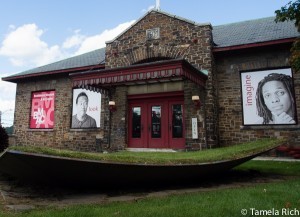
The BMAC has outstanding programming!
The Brattleboro Museum and Art Center is located on the top two floors of Union Station, situated on the rail line in front of the Anna Hunt Marsh bridge. At ground level is an Amtrak station.
What luck for me that the BMAC (as it’s called) was running an exhibit called “Road Trip: America Through the Windshield.”
The road has permanently changed the American landscape. It has allowed Americans to travel throughout the United States and learn more about the country’s diverse topography. Experiencing the landscape through the windshield has, at the same time, led to a certain alienation from it… ~BMAC
A lecture at the BMAC by psychotherapist Dave Cohen laid out “how the neuropsychology behind how the car radically mediates our sensory experience of the ecological and social environments we encounter.”
I took notes like there was no tomorrow, including:
Cars are designed to restrict our access to the “real world”
The limbic brain governs emotions and relies on sensory inputs, which are limited in a car. No wonder we love convertibles (and I love motorcycle travel)
There are studies of kids who can’t draw their neighborhoods. Why? Because they don’t explore them
We are antisocial when we get behind the wheel. Just watch this Disney short with Mr. Walker when he becomes Mr. Wheeler
The museum’s Flickr page offers a few pictures from the exhibit, which ran through October 2014; the BMAC isn’t a collecting museum.
A motorcyclist in a black dress
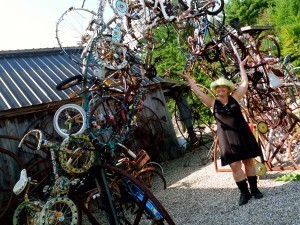
Here I am in my “little black dress” and motorcycle boots
I got a nice mention in The Brattleboro Reformer when I visited the BMAC. I had to laugh when the reporter described me as a motorcyclist wearing a black dress. Doesn’t that sound like cocktail party attire? Ha!
Here’s the scoop: this year I learned that riding my motorcycle with a dress tucked into my riding pants makes touring in hot weather a (literal) breeze. Jump off the bike, take off your armored riding pants, let the dress drop and whew.
It’s a wonder dresses for men haven’t taken off…you don’t know what you’re missing, guys.
Brattleboro has its own “Nessie?”
I’m a fan of roadside kitsch, so of course I got this picture of what I thought was the Loch Ness Monster on a Brattleboro lake north of downtown.
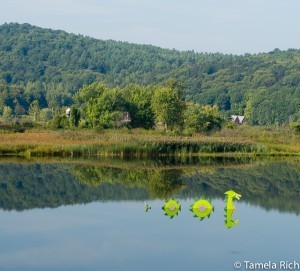
Roadside homage to “Champ” the monster of Lake Champlain
When I posted it on Facebook my friends in New England were quick to point out that my photo was really “Champ,” the monster of Lake Champlain.
From quirky shops and earnest purveyors of local and organic food and drink, to street musicians and the arts, there is plenty too see and do in Brattleboro. No extra charge for hippie culture!

November 10, 2014
Lunch with a Homeless Vietnam Veteran
Sometimes the people I meet in my travels give me an unexpected glimpse of a life that I could also be living. For better and for worse.
On my recent swing through New England, I visited Shelburne Falls, Massachusetts, known for its pedestrian-only Bridge of Flowers.
The bridge was built in 1908 for trolleys to cross the Deerfield River between the towns of Buckland and Shelburne. When the trolley line discontinued in 1928 the local women’s club took charge. Today, over 500 varieties of annuals and perennials are planted along the 400-foot span, thanks to the work of volunteers.

Yours truly with flowers that reminded me of fireworks!
After going shutter-crazy on the bridge with my new camera and touring some local art galleries, my traveling companion Jill and I returned to the Buckland side of the bridge, where we’d parked our bikes.
Some tea and cherries with a Vietnam veteran
McCusker’s Market and Deli was a great place to grab some local-organic produce to supplement our bagged lunches. Its tables faced the bridge; perfect for people-watching.
Shortly after sitting down and opening our feed sacks, a man in his late ’60’s (or so) ambled over and took the seat to my right. I had seen him earlier when we parked and figured he was a local, just passing the lovely Saturday as we were. We said “Good afternoon,” and he smiled and returned the greeting.
It didn’t take long for me to notice his un-showered tang, but I didn’t give it much thought. When I asked him if he lived in Buckland he replied that he was homeless until his benefits were approved and he could move near his daughter and grandchildren, some two hours away.
He said it as matter-of-factly as I may have said I was from Charlotte.
Candidly, I was in uncharted conversational territory. I asked if we could offer him something to drink and he graciously accepted the bottle of Honest Tea I proffered. He didn’t take his thanks over the top. I liked him for that.
It came to me that I shouldn’t put his homelessness at the center of our conversation. I had no business questioning him on the subject. I decided to treat him as I do every other person I meet by chance on my travels. So I asked him if there was anyplace he would recommend we see before we left the area.
We are more than our resumes convey
Over the next forty-five minutes of engaging conversation, we learned that he had served in Vietnam, had been an EMT with an ambulance service in Hawaii, and spoke a First Nations language in addition to English. We were fascinated by what he told us about some of the tribe’s matrilineal customs and spiritual practices.
We shared some cherries with him from the pint we bought at McCusker’s. At first he said he would only take a couple, but every few minutes or so I would wordlessly hand the green container over to him and he would delicately pluck one or two of them out by their stems. He refused everything else we offered him.
He had an older-generation phone with pictures of his grandchildren on it, and told us a couple of cute stories about them. In the course of conversation it came out that the benefits he currently receives are mailed to him at his daughter’s address, but they are insufficient for lodging. He hoped to have everything approved so he could get a little place by January, which made me wonder how he would keep body and soul together in the months between.
I looked at this week’s forecast. Daytime is mid-50’s and below freezing at night.
Homeless or “houseless?”
Several years ago I heard a middle-school student talk about what she learned about homelessness when she participated in a youth program sponsored by Mecklenburg Ministries, whose board I once chaired. She said she thought it should be called “houseless-ness” instead of “homeless-ness,” because many people she encountered during her volunteer service had a definite sense that our city is their home. They just need a safe, warm, dry place to live.
The homeless veteran I met definitely had the sense that Massachusetts was his “home.” Food for thought.
Doing our part for veterans
The VA systems have not been updated since 1985 “in an appreciative manner” according to congressional testimony this summer. Jon Stewart, of The Daily Show, offers an entertaining-while-scathing commentary on the VA.
Co-authors of a new book on veterans Howard Schultz (Starbucks CEO) and Rajiv Chandrasekaran (Washington Post Associate Editor) observe how difficult it is for veterans to get private-sector jobs.
The press, politicians and even many veterans’ advocacy groups tend to focus, with legitimate reason, on service members who have returned banged up or who are struggling in their new civilian lives…(Being asked) ‘Did you ever kill anyone?’ prompted one active-duty soldier to tell us that he is more nervous about sitting for a job interview than he is about redeploying to Afghanistan.
Here’s a video of the authors talking about some of the stories in their book and why Starbucks is so to hiring veterans.
Like me, you may not be in a position to affect national policy or to hire a veteran, but at an individual level, we shouldn’t jump to the conclusion that every veteran we meet is suffering from PTSD (post-traumatic stress syndrome) and shy away.
My life was enriched by that homeless veteran at the Bridge of Flowers. I’m grateful for the encounter and I’ll remember this Vietnam veteran on this and every Veterans Day.

November 7, 2014
Alonzo Cushing and my Gettysburg visit
First Lieutenant Alonzo “Lon” Cushing was decorated with the nation’s highest military honor for his service at Gettysburg. The presentation was more than 150 years in the making.
A West Point graduate, during the era of Cushing’s service, the Medal was not presented to officers. He fought at Bull Run, Anteitum, Chancelorrsville, Fredericksburg and finally Gettysburg, where he was immortalized on the final day of the fight on July 3, 1863.
At Cemetery Ridge during Picket’s Charge, Cushing was hit and badly wounded. His sergeant urged him to go to the rear but he said he would fight it out or die in the doing. Over 10,000 Confederates charged while Lon used his thumb to stop his gun’s vent from burning his fingers, and continued shooting. When he was hit a third and final time, he discharged a shot at the enemy.
“Faithful unto death” was his epitaph, and the dining room on the USS Gettysburg will be dedicated to him.
Congressional exemption for a Civil War hero
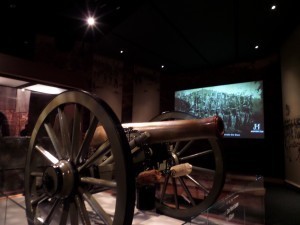
One of many terrific galleries at the Gettysburg National Military Park Museum and Visitor Center
The honor for Cushing required a congressional exemption because, under rules for the award—created during the Civil War—it must be presented within three years of a qualifying act of heroism. Relatives and historians worked for over 40 years to get the honor bestowed on the war hero.
The irony for me is that when I visited Gettysburg in 2013 the government was shut down in a partisan battle. I’m glad Congress can cooperate on something a year later!
Fortunately the visitor center was open during the shutdown because it’s run by a private foundation instead of a federal agency.
The Gettysburg experience
On a more somber note, I was quite moved by what I learned on my visit—about history and about myself. I hope you’ll listen to the podcast from that visit at the top of this post and visit the post I wrote about it.
I’ve visited several towns this year with Civil War history but the subject has always been remote. The war became personal to me in the exhibit hall of the Gettysburg National Military Park Museum. Comparing the uniforms and kits of the Union and Confederate soldiers, I was struck by how poorly outfitted Johnny Rebel was. They never stood a chance, and I married one of their descendants.
The Confederates had some strange ideas and were fueled by false hopes and hubris, but at that moment, I recognized them as family. Truth is, they’ve always been family, even before I married a Virginian. We’re all one human family.

October 28, 2014
Leaf Peeping and More in the Smoky Mountains
With a fabulous forecast in the region this week and weekend, I’m headed to the Smoky Mountains! Nothing like fresh air, beautiful scenery—hopefully some local apples—to invigorate the soul!
If you headed to the Smokies and are interested in camping at the beautiful KOA in Cherokee, North Carolina, good news: I called and learned that primitive cabins OFF the river are still available and there are plenty of deluxe cabins ON the river. We stayed in a deluxe cabin earlier this summer and loved it.
Cherokee events
The Museum of the Cherokee Indian always has great programs and this weekend is running a haunted Indian village while The Cherokee Historical Association, not to be outdone, is producing a “Little Dorm of Horrors.”
I will not see you at either of those, but we might bump into each other at the Oconaluftee Indian Village. November is Native American Heritage Month.
Leaf peeping and even some wildflowers on view

View of New Found Gap, courtesy of the National Park Service
Great Smoky Mountains National Park (GSM) gave this advice about leaf peeping: stick to roads that take you through the middle elevations for the best leaf viewing. The lower elevations areas haven’t hit 100% peak yet.
The service updates this page on its website as leaf season progresses, so check it as you make your plans.
For real-time updates, here are a couple of webcams at Purchase Knob and at Look Rock.
New Found Gap Road is top of my list because it’s in that middle elevation and you get to it on a twisty road (U.S. 441) from Cherokee, North Carolina to Gatlinburg, Tennessee.
View Larger Map
In the lower elevations, the leaves are still about 50% green. The peak will depend on the weather in the next 14-21 days. The peak usually hits the last few weeks of October through the first week in November, and all depends on the weather. The National Park Service doesn’t know when the peak will be even yet this year.
Many people also go to the park to view wildflowers, and while the peak for wildflowers has past, there are still some to view. Thanks, Mother Nature!
Events for adults and junior rangers, too
Several fall events are listed on the GSM web site. Here’s what came up on the search I ran for this weekend, with my personal choices below:
Indians, Bushwhackers, and Conscripts: The Civil War in the Smokies

October 26, 2014
Ted Simon: Lessons about Purposeful Travel
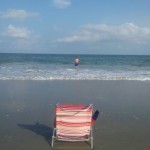
I spent last week at the beach with my spouse. I enjoy sitting at the water’s edge as I read, write, contemplate and doze, but I’m not often in the water past my knees. When Matt takes his fishing pole out to the surf, I fall into a lull watching him cast, reel in and repeat. It usually induces rumination.
One of those ruminations was the way travel leaves its imprint on you and how a purposeful traveler can leave the world a better place.
Ted Simon, solo globetrotter sans GPS
Lots of folks travel to expand their life’s purpose and find greater meaning in their lives. Ted Simon is one of those people. I met this legendary traveler at Overland Expo‘s Asheville, North Carolina venue earlier this month, and it could be said that he both inspired the modern overland movement and defined “purposeful travel” for an entire generation.
Ted first traveled the world by motorcycle in 1973 at age 42, when “it just wasn’t done.” He made his first trip on a 500cc motorcycle, smaller than the one I ride today. And he did it with neither support crew nor GPS.
Solo.
He did it again at age 69, eight years ago. Here’s what he said about his accomplishments:
People who thought of my journey as a physical ordeal or an act of courage… missed the point. Courage and physical endurance were no more than useful items of equipment for me, like facility with languages or immunity to hepatitis.
The goal was comprehension, and the only way to comprehend the world was by making myself vulnerable to it so that it could change me. The challenge was to lay myself open to everybody and everything that came my way. The prize was to change and grow big enough to feel one with the whole world.
Traveling for a vacation or a purpose, maybe even a cause
There’s a difference between traveling for vacation, traveling for a purpose and traveling for a cause.
A vacation is intended to be a time when you pull away from the everyday duties and schedules of life so you can rest and recreate. As an aside, I prefer to pronounce it “re-create” to remind myself that there’s more to recreation than fun and games.
Travel is a one of many ways to spend a vacation and a great way to re-create your thinking and yourself. I hope to encourage you to travel—somewhere, anywhere—to get to know yourself, your history, your world.
Ted Simon traveled the world solo because he wanted to make himself a better person. I consider this purposeful travel. To get the most of purposeful travel, try traveling alone, when you can really get to know yourself without someone else’s filter or influence (scroll down for tips on solo travel).
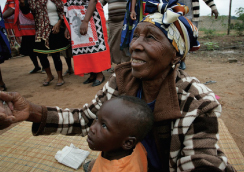
Ouma is a grandmother raising six orphans
This week my friend Neale Bayly, whom many of you will remember from our TEDx talk, will lead another motorcycle adventure in South Africa. At the end of their tour the riders will visit the new orphanage his charity is building outside Johannesburg for an 84-year-old grandmother raising six children. Their parents died of AIDS.
Neale travels for a cause: abandoned children around the world. Riders who tour with him raise or donate money for his charity’s projects.
Ride safely, Neale and friends. You can follow this project on Facebook for real-time updates.
Solo travel tips
Solo travel doesn’t mean you’ll be lonely. On the contrary! Here are some solo travel tips to get you started.
1. Become a third wheel. I often find that people traveling with others enjoy having me along for a meal or outing. I give them something new to talk about, to filter their experiences through andto break up the monotony they feel with their traveling companions. I’ve met some fascinating people by being a “third wheel.” Try it!
2. Put down that phone. Sharing every detail of your trip on Instagram, Facebook and texts allows little time to engage with real people and no time to reconnect to yourself as you wait for the responses to trickle in and respond in turn.
3. Talk to strangers. Don’t sit in a booth at a restaurant by yourself and watch TV. The bar or counter and family-style seating area is the perfect place to talk to other unattached travelers, the locals and waitresses. You can learn a great deal about the people and local history of the place you’re visiting if you keep an open mind and practice small talk.
Why do you go away? So that you can come back. So that you can see the place you came from with new eyes and extra colors. And the people there see you differently, too. Coming back to where you started is not the same as never leaving. ~Terry Pratchett, A Hat Full of Sky




